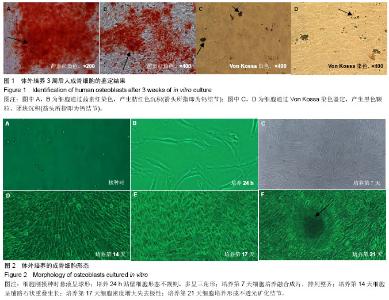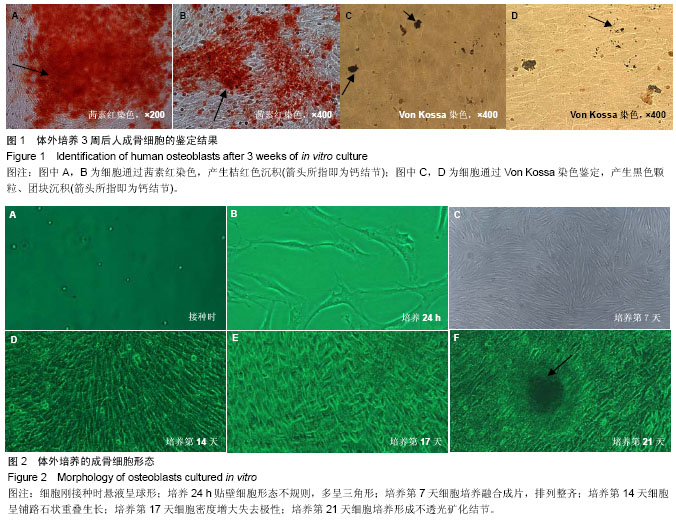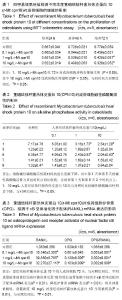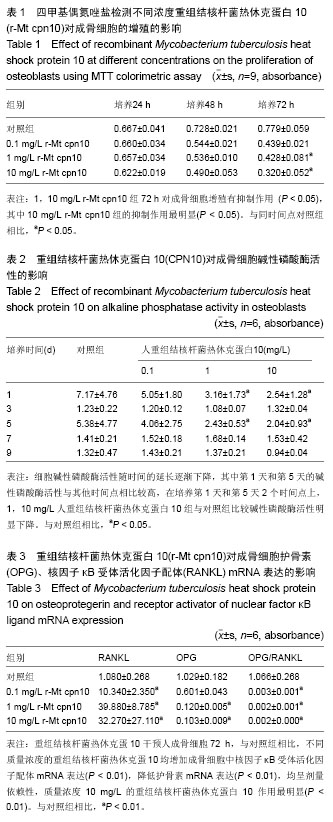| [1] Jain AK, Kumar J. Tuberculosis of spine: neurological deficit. European Spine J. 2013;22(suppl 4):624-633.[2] Wong BR, Besser D, Kim N, et al. Trance, a TNF family member,actives Akt/PkB through a signaling complex involving TRAF6 and c-Src. Mol Cell. 1999;4(6):1041-1049.[3] Jones DH, NakashIma T, Sanchez OH, et aI. Regulation of cancer cell migration and bone metastasis by RANKL. Nature. 2006;440(7084):692-696.[4] Qamra R, Shekhar CM, Anthony RM, et al. The unusual chaperonins of Mycobacterium tuberculosis. Tuberculosis. 2005;85(5-6):385-394.[5] Meghji S, White PA, Nair SP, et al. Mycobacterium tuberculosis chaperonin 10 stimulates bone resorption: a potential contributory factor in Pott’s disease. J Exp Med. 1997;186(8):1241-1246.[6] Castanié-Cornet MP, Bruel N, Genevaux P. Chaperone networking facilitates protein targeting to the bacterial cytoplasmic membrane. Mol Cell Res. 2013;81(6):87-91.[7] Ravikiran M, Alfred L, Goldberg, et al. Bacterial proteolytic complexes as therapeutic targets. Nature reviews drug discovery. 2012;11(10):777-789.[8] 殷晓雪,陈忠强,郭邵庆,等.人骨髓干间充质干细胞定向诱导分化为成骨细胞及其鉴定[J].中国修复重建外科杂志,2004,18(2): 88-91. [9] 殷晓雪,陈忠强,党耕町,等.淫羊藿苷对人成骨细胞增殖与分化的影响[J].中国中药杂志,2005,30(4):289-291.[10] 郭宗科,章庆国,李静,等.比较不同来源人成骨细胞的体外培养模式及生物学特性[J].中国临床康复,2006,10(13):51-53.[11] 仲蕾蕾,杨冰,黄晓斌,等.OPG/RANKL/RANK系统在成骨细胞和破骨细胞相互调节中的作用[J].中国骨质疏松杂志,2011, 17(11): 1010-1013.[12] Martin TJ. Historically significant events in the discovery of RANK/RANKL/OPG. World J Orthop. 2013;4(4):186-197. [13] William CD. Molecular pathway: osteoclast-dependent and osteoclast-independent roles of the RANKL/RANK/OPG Pathway in tumorigenesis and metastasis. Clin Cancer Res. 2012;18(2):326-335. [14] Raju R, Lavanya B, Vishalakshi N, et al. A comprehensive manually curated reaction map of RANKL/RANK-signalling pathway. Database. 2012;2011:bar021. [15] Hess E, Vincent D, Marion D, et al. RANKL induces organized lymph node growth by stromal cell proliferation. J Immunol. 2012;188(3):1245-1254.[16] Kirsten M, Remen R, Henning P, et al. Activation of Liver X Receptor(LXR) inhibits receptor activator Nuclear factor kB Ligand (RANKL)-induced Osteoclast Differentiation in an LxRb-dependent Mechanism. J Biol Chem. 2012;286(38): 33084-33094.[17] Kaichi K, Natsuko K, Tomoko H, et al. Changes of serum soluble receptor activator for nuclear factor-kb ligand after glucocorticoid therapy reflect regulation of its expression by osteoblasts. J Clin Endocrinol Metab. 2012;97(10):E1909-E1917. [18] Kyoung W, Hae K, Bo M, et al. Stromal cell-derived factor(SDF)-1 induces RANKl in Rheumatoid Arthritis synovial fibroblasts and CD4+ T cells. FASEB J. 2012; 26(5):655-665. [19] Stuss M, Rieske P, Ceqlowska A, et al. Assessment of OPG/RANK/RANKL gene expression levels in peripheral blood mononuclear cells (PBMC) after treatment with strontium ranelate and ibandronate in patients with postmenopausal osteoporosis. J Clin Endocrinol Metab. 2013;98(5):E1007-E1011. [20] 刘继中,纪宗玲,陈苏民.OPG/RANKL/RANK系统与骨破坏性疾病[J].生物工程学报,2003,19(6):655-660.[21] Wong BR, Besser D, Kim N, et al. Trance, a TNF family member,actives Akt/PkB through a signaling complex involving TRAF6 and c-Src. Mol Cell. 1999;4(6):1041-1049. [22] Jones DH, NakashIma T, Sanchez OH, et al. Regulation of cancer cell migration and bone metastasis by RANKL. Nature. 2006;440(7084):692-696.[23] Mogi M, Otogoto J, Ota N, et al. Togari differential expression of RANKL and osteopro tegerin in gingival crevicular fluid of patients with periodontisis. J Dent Res. 2004;83(2):166-169.[24] Samelson EJ, Broe KE, Demissie S, et al. Increased piasma osteoprotegerin concentrations are associated with indices of bone strength of the hip. J Clin Endocrinol Metab. 2008;93(5): 1789-1795.[25] Grimaud E, Soubigou L,Couillaud S, et al. Receptor activator of nuclear factor kb ligand(RANKL), osteoprotegerin (OPG) ratio is increased in sever osteolysis. Am J Pathol. 2003; 163(5):2021-2031.[26] Kearns AE, Khosla S, Kostenuik PJ. Receptor activator of nuclear factor kappaB ligand and osteoprotegerin regulation of bone remodeling in health and disease. 2008;29(2): 155-192.[27] Lamoureux F, Richard P, Wittrant Y, et al. Therapeutic relevance of osteoprotegerin gene therapy in osteosarcoma: blockade of the vicious cycle between tumor cell proliferation and bone resorption. Gancer Res. 2007;67(15):7308-7318.[28] Joseph F, Chan BY, Durham BH, et al. The circadian rhythm of osteoprotegerin and its association with parathyrold hormone secretion. J Ciin Endocrinol Metab. 2007;92(8): 3230-3238.[29] Corrado A, Neve A, Macchiarola A, et al. RANKL/OPG ratio and dkk-1 expression in primary osteoblastic cultures from osteoarthritic and osteoporotic subjects. J Rheumatol. 2013; 40(5):684-694. [30] Foley NM, Miller RF. Tuberculosis and AIDS: Is the white plague up and coming? J Infect. 1993;26(1):39-43 .[31] Henderson B, Peter A, Anthony RM, et al. Multiple moonlighting functions of mycobacterial molecular chaperons. Elesvier Tuberculosis. 2010;90(2):119-124.[32] Taneja B, Mande SC. Metal ions modulate the plastic nature of Mycobacterium tuberculosis chaperonin-10. Protein Eng. 2001;14(6):391-395. [33] Fossati G, Izzo G, Rizzi E, et al. Mycobacterium tuberculosis chaperonin 10 is secreted in the macrophage phagosome: is secretion due to dissociation and adoption of a partially helical structure at the membrane? J Bacteriol. 2003;185(14): 4256-4267.[34] Zhang YH, Heulsmann A, Tondravi MM, et al. Tumor necrosis factor-alpha stimulates osteoclastogenesis via coupling of TNF type 1 receptor and RANK signaling pathways. J Biol Chem. 2001;276(1):563-568. [35] Kaqiva T, Nakamura S. Expression profiling of microRNAs in RAW264.7 cells treated with a combination of tumor necrosis factor alpha and RANKL during osteoclast differentiation. J Periodontal Res. 2013;48(3):373-385.[36] Harre U, Schett B. The ups and downs of bone in health and rheumatic disease. Rheumatol. 2013;9(2):67-68.[37] Julia F, Coury F, Rosalyn S, et al. The collection of NFATc1-dependent transcripts in the osteoclast includes nuerous genes non-essential to physiologic bone resorption. Bone. 2012;51(5):902-912.[38] Yarilina A, Xu K, Chen J, et al. TNF activates calcium-nuclear factor of activated T cells (NFAT)c1 signaling pathways in human macrophages. PNAS. 2011;108(4):1573-1578. |



